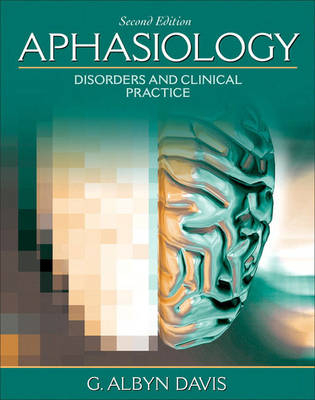
Aphasiology
Pearson (Verlag)
978-0-205-48099-9 (ISBN)
- Titel ist leider vergriffen;
keine Neuauflage - Artikel merken
Written in a highly accessible style, this text carefully explains and illustrates key paradigms in research and treatment. The author uses tables to summarize essential points and to provide historical overviews.
Structured according to a course outline, the book begins with etiology and moves quickly to clinical assessment. It teaches diagnostic thinking with respect to the relationships between symptoms and hidden impairments in cognitive terms. This thinking is illustrated with research as well as more explicitly with assessments and treatments. Through this approach, a future clinician should acquire an appreciation for the scientific investigation that supports a clinical discipline.
The Second Edition features updated information on many topics, such as functional assessments and treatments (including ethnography and outcome measures) and medical aspects and treatments keep the text current and competitive in the field. It also includes a new chapter on dementias supplements current chapters on other cognitive disorders (right hemisphere dysfunction and traumatic brain injury). Each of these chapters includes additional information on rehabilitation as well as up-to-date information on current research. The content has been reorganized within and between chapters to maximize readability and ease of use as a course text. Psycholinguistics background has been restructured to improve efficiency and readability of the text. Chapter 6 on “Special Investigations” has been eliminated from this edition and its topics have been redistributed, improving the overall flow of the text.
Preface.
1. INTRODUCTION TO ACQUIRED LANGUAGE DISORDERS
Diagnosing aphasia
Describing aphasia
Explaining aphasia
Treating aphasia
2. CAUSES OF THE APHASIAS
Stroke
Ischemic stroke
Hemorrhage
Tumor
Focal cortical atrophy
Clinical neurological examination
Clinical brain imaging
Localization and dissociation
Clinical syndromes of aphasia
Exceptional aphasias
Summary and conclusions
3. CLINICAL ASSESSMENT AND DIAGNOSIS
The first visit
Diagnostic decisions
Standard testing
Psychometric constraints: The PICA
Diagnosing syndromes: The Boston Exam
Numerical classification: The WAB
Diagnosing modular impairment: PALPA
Brief tests and bedside screening
Supplemental tests
Notes on interpretation
Martin Exeter’s initial report
Summary and conclusions
4. INVESTIGATING APHASIA IN GENERAL
Basic research in clinical aphasiology
Word processing
Sentence comprehension
Explaining sentence comprehension deficit
Object naming
Productive word-finding
Reading words
Aphasia in bilingual individuals
Summary and conclusions
5. INVESTIGATING SYMPTOMS AND SYNDROMES
Agrammatism
Asyntactic comprehension
Anomic aphasia
Conduction aphasia
Wernicke’s aphasia
Universal aphasia
Martin Exeter’s aphasia
Summary and conclusions
6. DISCOURSE AND COMMUNICATION
Pragmatic language
Discourse and text
Discourse comprehension with aphasia
Aphasic discourse production
Conversation
Nonverbal modalities
Overall functional status
Assessment of functional communication
Assessing life participation
Martin Exeter’s functional skills
Summary and conclusions
7. RECOVERY AND PROGNOSIS
Stroke and functional outcomes
Measuring recovery of language
Approaches to prognosis
Type of stroke
Severity of impairment
Type of impairment
Other factors
Making the targeted prognosis
Bilingual recovery
Explaining recovery
Martin Exeter’s recovery
Summary and conclusions
8. PRINCIPLES OF LANGUAGE RESTORATION
Cognitive stimulation
Programmed stimulation
Measurement and generalization
Word-finding
Computer-assisted treatment
Group treatment
Efficacy of standard aphasia treatment
Medical treatments
Health care topics
Notes from the clinic
Summary and conclusions
9. TARGETING SPECIFIC DISORDERS
Studying individual cases
Agrammatic production: Empirical treatments
Agrammatic production: Theory-driven treatments
Asyntactic comprehension
Wernicke’s aphasia
Conduction aphasia
Anomic or mild aphasia
Reading impairments
Summary and conclusion
10. FUNCTIONAL THERAPEUTICS
Philosophy: The clinical-functional gap
Functional stimulation
Compensatory behaviors
Interactive therapies
Life participation
The challenge of severe or global aphasia
Psychosocial adjustment
Documenting functional outcome
Martin’s conclusion
Summary and conclusions
11. RIGHT HEMISPHERE DISORDERS
Clinical neuropsychology
Awareness of deficits
Left neglect and reading
Visuospatial orientation
Constructional skills
Problems with sound
Emotion and prosody
Speaker meaning
Discourse
What is RHD syndrome?
Clinical assessment
Treatment
Recovery and outcomes
Summary and conclusions
12. TRAUMATIC BRAIN INJURY
Head trauma
The trauma unit
Neuropsychological assessment
Attention
Memory
Executive functions
Personality and behavior
Insight (awareness)
Language
Pragmatics and discourse
Cognitive rehabilitation
Recovery and outcomes
Summary and conclusions
13. DEMENTIAS
Diagnosis and assessment of dementia
Alzheimer’s disease
Other causes of dementia
Dementia of Alzheimer’s type
Language with Alzheimer’s disease
Medical treatments
Communicative assessment
Cognitive-communicative interventions
Summary and conclusions
References.
| Erscheint lt. Verlag | 5.10.2006 |
|---|---|
| Sprache | englisch |
| Maße | 195 x 246 mm |
| Gewicht | 800 g |
| Themenwelt | Medizin / Pharmazie ► Gesundheitsfachberufe ► Logopädie |
| Medizin / Pharmazie ► Medizinische Fachgebiete ► HNO-Heilkunde | |
| ISBN-10 | 0-205-48099-3 / 0205480993 |
| ISBN-13 | 978-0-205-48099-9 / 9780205480999 |
| Zustand | Neuware |
| Haben Sie eine Frage zum Produkt? |
aus dem Bereich


